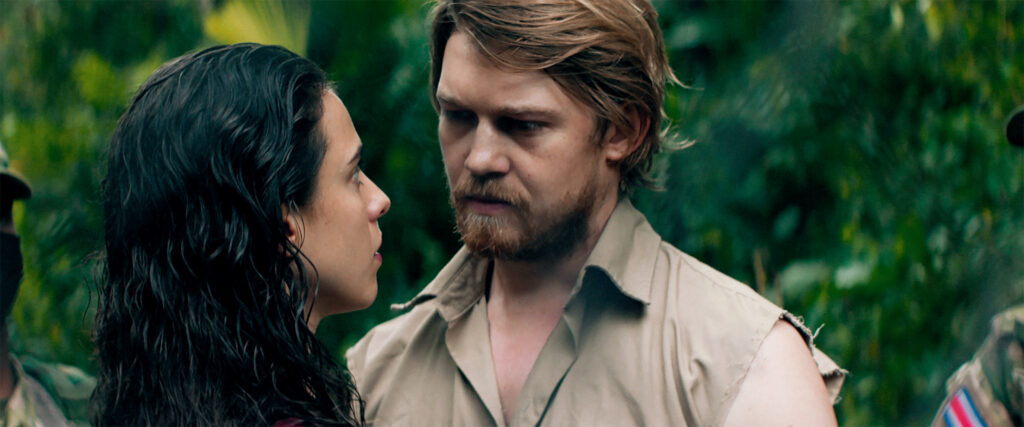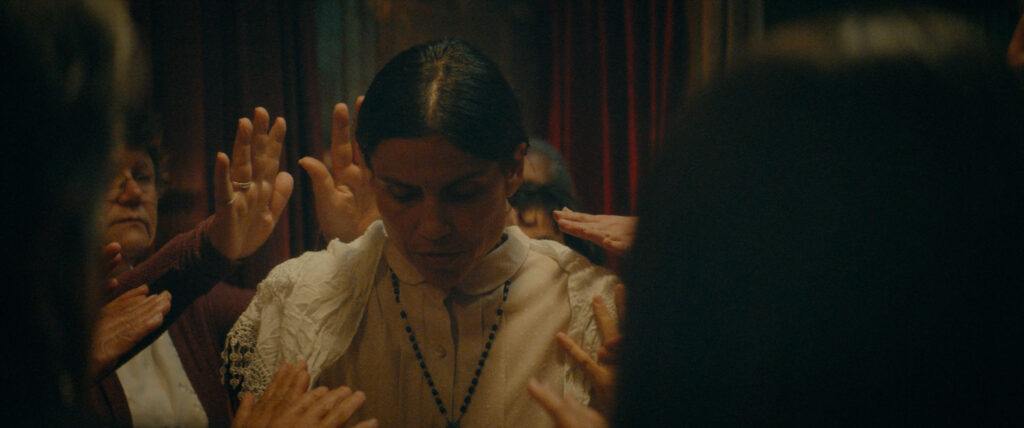October 23, 2022
by Carla Hay

Directed by Claire Denis
Culture Representation: Taking place in Nicaragua and Costa Rica in the early 2020s, the dramatic film “Stars at Noon” features a cast of white and Latino characters representing the working-class and middle-class.
Culture Clash: An American journalist, who’s stranded in Nicaragua and doing sex work for money, gets involved with a mysterious British man, who has shady people chasing after him.
Culture Audience: “Stars at Noon” will appeal mainly to people who are fans of filmmaker Claire Denis, but this frequently dull misfire of a film will disappoint anyone looking for an intriguing, well-written story.

“Stars at Noon” is a messy and boring drama that’s an example of the worst type of pretentious self-indulgence, not only from the main characters but also the filmmakers. The dialogue is awful and unrealistic. And the acting isn’t much better. The cast members who portray the would-be couple at the center of the story do not have believable chemistry with each other. “Stars at Noon” had its world premiere at the 2022 Cannes Film Festival in France, and its U.S. premiere at the 2022 New York Film Festival in New York City.
Directed by Claire Denis, “Stars at Noon” is adapted from Denis Johnson’s 1986 novel “The Stars at Noon.” Denis, Andrew Litvack and Léa Mysius co-wrote the “Stars at Noon” adapted screenplay. The screenplay is the weakest link in this dreadful movie, which is filled with cringeworthy conversations that sound very fake and nonsensical. Denis’ direction also falters in “Stars at Noon,” by making what should have been an engaging thriller into a sluggish and annoying jumble of self-important garbage that rambles and stumbles until the movie’s underwhelming conclusion.
“Stars at Noon” irritates from the moment that viewers find out it’s peddling a “Pretty Woman” fantasy, where an irreverent sex worker expects one of her male customers to come to her rescue and save her from a life of desperation and degradation. That’s essentially what the entire movie is about, even though the filmmakers try to dress it up and fool audiences into thinking it’s an adventerous story about two “outlaw lovers” on the run. The “Stars at Noon” movie changes the book’s 1980s time period, so that the movie takes place in the early 2020s, during the height of the COVID-19 pandemic. The era might have been updated for the movie, but “Stars at Noon” is filled with a lot of old-fashioned misogyny.
The misogyny is very apparent in how lead character Trish Johnson (played by Margaret Qualley) is written and presented as a whiny ditz who gets herself into predicaments and doesn’t have the common sense to get herself out of them. Trish is an American who’s stranded in Managua, Nicaragua, because a police officer called Subtenente Verga (played by Nick Romano) has taken her passport. Why? Verga suspects she’s doing an undercover investigation as a journalist.
“The Stars at Noon” book was set in the backdrop of the Nicaraguan Revolution, during the Contra War phase, when the left-wing Sandinista National Liberation Front overthrew the right-wing Somoza dictatorship. The entire Nicaraguan Revolution spanned from 1961 to 1990. Because the “Stars at Noon” movie takes place in the early 2020s, the Nicaraguan political turmoil is never fully explained. There are some vague references to Trish trying to uncover government corruption.
Trish calls herself a journalist, but she doesn’t do any journalism work in this movie. All she does for money is have sex with men, including Subtenente Verga, because she’s hoping that having sex with him will convince him to give her passport back to her. It isn’t necessarily misogynistic to show that Trish is doing sex work for money. (Sex workers are often desperate people who shouldn’t be judged too harshly by society.) What’s misogynistic about this portrayal is that Trish (who likes to tell everyone how smart and resourceful she is) is made to look like an idiot who hasn’t figured out other ways to make money where she doesn’t have to sexually degrade herself.
Trish speaks fluent Spanish. Apparently, it never occurred to her to get work as a translator/interpreter. And as a so-called journalist, she’s so lacking in basic common sense, it’s embarrassing. You don’t have to be a journalist to know that if you’re an American citizen whose passport is lost or stolen in a foreign country, you can go to the U.S. embassy in that country to get an emergency passport re-issued. Trish does none of these things, of course, because there would be no “Stars at Noon” movie if Trish actually had the intelligence that she thinks she has.
Trish has a very off-putting way of trying to make people she interacts with seem inferior to her, when her whole life is such a train wreck, she’s in no place to judge. She actually doesn’t have a journalist assignment to be in Nicaragua. Trish apparently went there hoping to find something to “investigate” and then sell the story later.
A scene that comes about midway through the movie shows that Trish is also a failure as a journalist. She makes a videoconference call to an unnamed American magazine editor (played by John C. Reilly, making a cameo), and she begs him to give her an assignment. The editor works at a monthly magazine about sustainable, high-class travel. Trish pitches a story idea to him, by saying she can do an article about a nature reserve in Costa Rica.
The editor gives Trish an emphatic “no” to her pitch. He also reminds Trish that the last time he gave her an assignment, she just took the advance money and never delivered the assignment. In other words, Trish has burned her bridges with this editor. He tells her to lose his number and never contact him again.
Before this unpleasant conversation happened, Trish had gotten sexually involved with a British man named Daniel DeHaven (played by Joe Alwyn), whom she met at a bar in Managua. Daniel, who likes to dress in immaculate white suits, tells Trish in their first meeting that he’s a consultant for a British oil company named Watts Oil. Daniel isn’t really telling the truth about his identity. It soon becomes apparent that some menacing-looking people are chasing after Daniel.
This is the vapid conversation that Trish and Daniel have when they first meet in the bar. Daniel tells Trish that he’s from London, and he asks her where she’s from. Trish replies, “From here, there and yonder.” She then tells him, “You have the kind of manners that can get you killed out here.” Trish then says that she’s a special correspondent in “the north area.”
Daniel asks her, “Are you for sale?” Trish replies, “I’m press.” Daniel says that he’s a member of the press too. (He’s really not.) Trish answers, “Then, we’re all for sale.” Trish asks him to have supper with her, but Daniel declines because he says it’s too late in the night. Trish then bluntly tells him, “For a price, I’ll sleep with you.”
Trish insists that Daniel pay her in American dollars. Her price? A measly $50. It’s just more of the film’s misogyny on display. And to make Trish look like even more moronic, she doesn’t get the payment up front, like a street-smart sex worker is supposed to do. She gets the money after she has sex with Daniel.
So what does this tell audiences about Trish? She’s not only stupid, but she also sells herself short as a sex worker. And yet, throughout the entire movie, she acts like a know-it-all, when she actually knows very little. It’s very hard to respect any character who is this aggressively obnoxious and dumb.
During the first sexual encounter between Daniel and Trish, this is the type of mindless conversation that they have. Trish tells him, “Your skin is so white, it’s like being fucked by a cloud.” Is that supposed to be a compliment?
At some point during this encounter, Daniel tells Trish that he’s married. “I commit adultery often.” Trish doesn’t care. After Daniel pays her, Trish tells him, “I’m not here for the dollars. I’m here for the air conditioning.”
If you have the patience to sit through all of “Stars at Noon,” get used to more of this eye-rolling, mind-numbing, extremely aggravating dialogue, because the movie is full of it. Of course, since the movie is pushing a tale of “outlaw lovers on the run,” it isn’t long before Trish finds out that Daniel has dangerous people who are after him.
Because Trish is desperate to get out of Nicaragua, and she knows Daniel has the type of money that she doesn’t, Trish figures that she can go on the run with Daniel, and he can help her in some way get back to the United States. Daniel and Trish commit some crimes and end up in various places in Nicaragua and then Costa Rica. And the movie tries very hard to convince viewers that Daniel and Trish fall in love. But it’s never believable.
Trish is just a self-absorbed flake who complains a lot. Daniel is a blank void who hides a lot of information about himself and never comes across as someone who could genuinely fall in love with someone like Trish. Qualley seems to be making an effort to bring sympathy in her portrayal of this very silly and selfish character, but Trish is just too much of a babbling mess for most viewers to care about her. Alwyn seems to be going through the motions in his performance.
Daniel sees right through Trish’s insecurity, and makes some cutting remarks to her in a scene that happens shortly after they had sex for the first time. In this scene, Daniel and Trish are hanging out together in a bar in Nicaragua. Trish is acting superior to him, as usual. But then, Daniel tells her that prostitutes like to think that they’re in control of their customers, when they’re not, because the prostitutes depend on their customers for money. There’s enough truth in this statement that it leaves Trish (temporarily) speechless, because she can’t think of a snappy comeback.
It’s one of the few times in “Stars at Noon” where a conversation actually resembles something that could take place in real life. But the vast majority of this bloated movie (which has a too-long total running time of 136 minutes) is just a shambolic and tedious slog of Daniel and Trish trying to avoid capture while sometimes arguing and having sex. The Daniel/Trish sex scenes, which are very monotonous and generic, fail to convince that Daniel and Trish are together because of passionate lust.
The supporting characters in “Stars at Noon” are so hollow and underdeveloped, most of them don’t even have names or distinctive personalities. An unnamed Costa Rican cop (played by Danny Ramirez), who’s one of the people chasing after Daniel and Trish, does a lot of predictable sneering and smirking. An unnamed CIA operative (played by Benny Safdie), who’s also looking for this “outlaw couple,” spouts horrendous lines of dialogue while looking smug.
This what the CIA operative says when he comments on female sex workers: “They’re all as lonely as widows. They haven’t had a man’s hand on their thighs since Jesus was in diapers and Moses had a pacifier.” If this the type of trash screenwriting that you think is quality filmmaking, then perhaps you might like “Stars at Noon.” Everyone else is best advised to steer clear of this horrible movie.
A24 released “Stars at Noon” in select U.S. cinemas, on digital and VOD on October 14, 2022. Hulu will premiere the movie on October 28, 2022.


